Can a virtual foundry cut weeks from development cycles and save millions in scrap while improving part quality?
We introduce Metal Casting Simulation: How Virtual Foundries are Transforming Manufacturing. It’s a guide for engineers, students, and educators, mainly in India’s manufacturing sector.
This series covers metal casting simulation, virtual foundries, and foundry simulation technology. We’ll show how to map workflows and explain key software and 3D simulation tools. Digital design tools play a big role in this transformation.
Our goal is to offer a detailed yet easy-to-follow guide. We mix hands-on practice with teaching. This includes simulations, optimization techniques, and examples for Indian foundries.
Key Takeaways
- We define how metal casting simulation accelerates product development and reduces defects.
- Virtual foundries combine simulation and CAD to shorten lead times and lower costs.
- Foundry simulation technology integrates with common 3D simulation software for practical workflows.
- The guide balances technical depth with teaching—aimed at engineers and educators in India.
- Readers will learn a clear, stepwise approach from CAD to validated simulation results.
Introduction to Metal Casting and the Role of Simulation
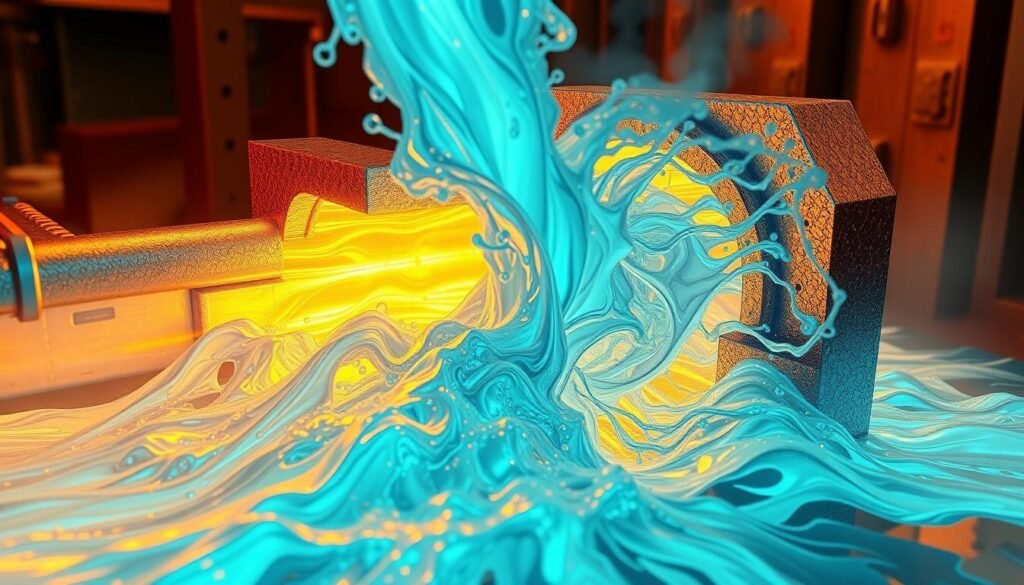
Metal parts start as molten alloys poured into molds. They solidify, then go through shakeout, fettling, heat treatment, and machining. Methods include sand casting, investment casting, die casting, and continuous casting.
In India, foundries use cast iron, aluminum alloys, steel, and non-ferrous alloys. They meet needs in automotive, pump, and machine-tool sectors.
What is metal casting?
Metal casting turns raw metal into parts by pouring liquid metal into molds. The mold shapes the part. After casting, operations refine the surface to match drawings.
Each casting method has its use. Sand casting is for large parts, investment casting for details, die casting for precision, and continuous casting for long billets.
Why simulation matters in modern foundries
Many shops rely on trial and error, leading to unpredictable results. Simulation models help predict risks like porosity and shrinkage before making tools.
Simulation lets us test virtual pours to improve process control. It boosts quality and reduces waste.
Overview of traditional casting vs. simulated workflows
Traditional workflows use physical prototypes and testing. Each change means new tooling and more trial casts. This is time-consuming and expensive.
Simulated workflows start in CAD and use digital tools. They let teams test many variables quickly. This approach optimizes the casting process by reducing physical trials.
Using advanced manufacturing techniques and digital tools enhances shop-floor skills. It helps foundries meet production targets faster and with fewer surprises.
Challenges in Traditional Metal Casting Methods
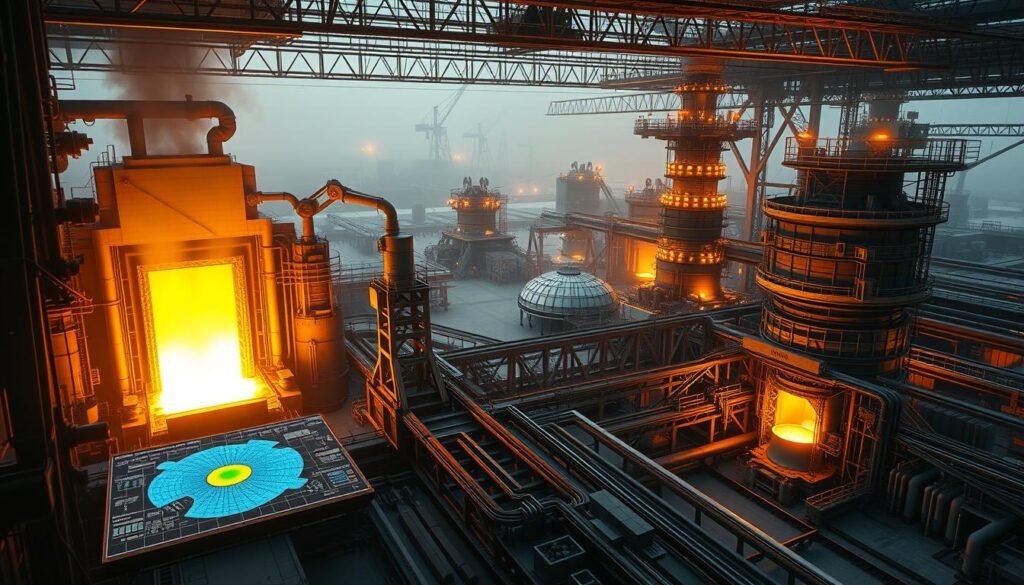
We face many challenges in traditional foundry work. These include slow product delivery and high costs. Manual trial-and-error, long lead times, and unpredictable quality make scaling hard for Indian manufacturers aiming for global standards. This is why there’s growing interest in foundry simulation technology and metal casting simulation for manufacturing transformation.
Common casting defects:
Porosity comes in two forms: gas and shrinkage. Gas porosity is when gases form bubbles. Shrinkage porosity happens when metal volume decreases during solidification.
Hot tears and cracks occur when thermal strains exceed the alloy’s ductility while cooling. Cold shuts and misruns happen when separate metal fronts fail to fuse or the molten metal stops short of filling thin sections. Inclusions and sand fusion arise from foreign material or mold breakdown. Dimensional distortion occurs when uneven cooling causes warping.
Process choices often cause these issues. Improper gating, insufficient feeding, trapped gases, rapid cooling gradients, and alloy chemistry can all be culprits. These problems lead to repeat work and scrap, eroding margins across a production run.
Costs of trial-and-error prototyping:
Raw material waste from failed pours and excess machining add up quickly. Pattern and tooling rework increase direct expenses. Lost production time from redesigns costs labor and machine availability. Inspection and rework labor intensify per iteration.
Each prototype cycle multiplies these drivers, extending time-to-market for new castings. The typical cost breakdown includes material, tooling, labor, and downtime as primary contributors. For medium-complexity parts, three to five prototype iterations are common without simulation, which can double total program cost and push deliveries months past plan.
| Cost Category | Typical Impact per Iteration | How Simulation Reduces It |
|---|---|---|
| Raw materials | 10–25% increase from scrap and oversize runs | Optimizes gating and reduces scrap by predicting fill behavior |
| Tooling & patterns | 15–30% extra due to redesigns and corrective machining | Validates designs virtually to minimize costly tooling changes |
| Labor & inspection | 20–35% rise from rework and additional QA cycles | Focuses inspection on high-risk areas identified by simulation |
| Downtime & scheduling | Variable delays from lost furnace and machine slots | Shortens trial cycles and improves production planning accuracy |
Time delays and production bottlenecks:
Mold cure times and furnace availability set fixed limits on throughput. Heat treatment and machining often become choke points when castings arrive late or need rework. Defective castings ripple downstream, causing assembly delays and missed delivery windows for OEMs in automotive and heavy machinery sectors.
These constraints encourage investment in process validation before physical trials. Foundry teams that adopt metal casting simulation can reduce iteration counts, smooth scheduling, and cut cycle time. This leads to a clearer path toward manufacturing transformation without sacrificing quality.
What Metal Casting Simulation Means for Manufacturers

Casting is now a science, thanks to physics. Metal casting simulation models how molten metal fills and solidifies. It also looks at heat transfer and the mechanical response that follows.
These models turn guesses into facts. Designers test different designs in a virtual world before making any real changes.
Definition and core concepts of casting simulation
Casting simulation uses physics to predict how metal fills a mold. It then looks at solidification and how parts change shape as they cool. It also predicts defects like porosity and shrinkage before they happen.
Core modules include mold filling, solidification, thermal analysis, mechanical response, and defect mapping.
How virtual testing complements physical testing
Virtual testing is like a filter that narrows down options. It finds the best layouts and identifies possible failures. This way, we need fewer full-scale pours.
Teams use simulation results to place thermocouples and sensors. This makes lab trials more focused and efficient.
By combining lab trials with virtual foundries, we get faster and more precise results. This leads to faster design improvements, better quality, fewer mistakes, and more consistent results.
This approach helps Indian foundries meet high standards in the automotive and industrial sectors.
Metal Casting Simulation: How Virtual Foundries are Transforming Manufacturing

Digital environments are changing how we cast metal. A virtual foundry is a digital space that covers the whole casting process. It goes from CAD to mold design, simulation, scheduling, and quality checks. This makes the link between design and production strong and fast.
Concept of virtual foundries and digital process chains
The digital process chain is clear: CAD -> simulation -> optimization -> digital twin -> production integration. Digital tools help engineers improve designs. Foundry simulation technology predicts how the metal will behave. This means fewer trial runs and a smoother transition to production.
Impact on lead times, quality, and repeatability
Virtual foundries make development faster by working in parallel. Design, tooling, and process engineering can all happen at the same time. This leads to quicker production and better quality.
Consistent dimensions and predictable properties come from using simulation for gating and riser placement. Digital tools ensure that CNC programs and process control systems follow validated parameters. This makes production more repeatable.
Case examples of virtual foundry implementation
Automotive suppliers using MAGMASOFT have seen less porosity and lower scrap rates. Aerospace shops with ProCAST have tighter control over critical castings and faster certification. Heavy-equipment makers use FLOW-3D to create large castings with fewer tooling changes.
These examples show how manufacturing is changing. There are fewer prototypes, clearer problems, and faster products. Foundry simulation and digital design tools are making Indian manufacturers competitive globally.
| Use Case | Software | Primary Benefit | Measured Outcome |
|---|---|---|---|
| Automotive supplier | MAGMASOFT | Reduce porosity and optimize gating | Scrap rate cut by 30%, first-pass yield up 20% |
| Aerospace component shop | ProCAST | Control safety-critical microstructure | Certification time reduced by 25%, fewer reworks |
| Heavy-equipment manufacturer | FLOW-3D | Scale prototype designs to large castings | Tooling revisions reduced by 40%, lead time cut 35% |
Key Components of a Metal Casting Simulation Process
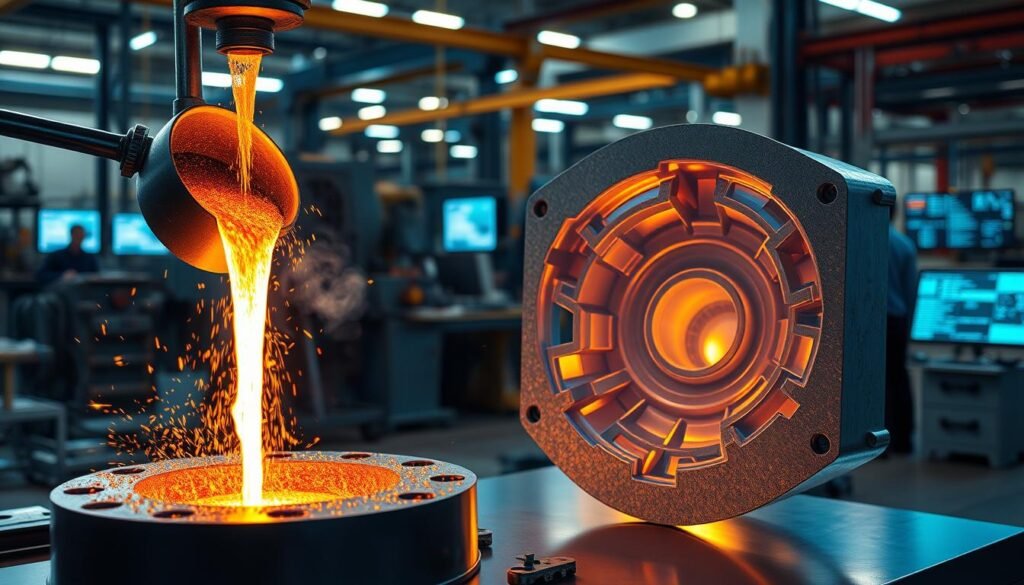
We explain the main parts of metal casting simulation. These parts help foundries and engineering teams. Each part is a step from idea to real results. This makes sure we can improve quickly and trust our tools and production.
CAD models and geometry preparation
We start with clean CAD geometry. We remove small details and faces that cause problems. Tools like SolidWorks and Inventor help simplify parts while keeping important details.
We keep tolerances reasonable. This avoids tiny errors and makes it easier to split parts. Including gating and riser details in the model helps avoid later mistakes. Good geometry means fewer errors and faster results with 3d simulation software.
Meshing strategies and resolution trade-offs
We find a balance between mesh detail and how long it takes to compute. Fine meshes are good for thin parts but use more resources. Coarse meshes are faster but might miss important details.
Adaptive meshing and local refinement are common methods. Hexahedral meshes are good for straight parts, while tetrahedral meshes work for complex shapes. The right meshing strategy depends on the part’s physics and the software’s capabilities.
Material models and thermal-mechanical properties
Getting material properties right is key. We include specific heat, conductivity, and how it changes with temperature. For stress analysis, we add elastic modulus and yield strength.
Using trusted sources like SAE and ASTM is important. Different materials like cast iron and stainless steel need specific models. This helps predict problems like porosity and shrinkage.
Here’s a quick guide for setting up common casting tasks.
| Setup Area | Best Practice | Why it matters |
|---|---|---|
| Geometry | Water-tight CAD, defeaturing, defined parting lines | Prevents mesh failures and reduces solver time |
| Meshing | Adaptive mesh with local refinement; hexa for simple regions, tetra for complex | Balances accuracy and compute cost using meshing strategies |
| Material Data | Temperature-dependent properties from SAE/ASTM or suppliers | Enables realistic thermal cycles and defect prediction |
| Gates & Risers | Model explicitly in CAD; refine mesh locally | Improves prediction of feeding and shrinkage |
| Solver Selection | Choose tools with proven metal casting modules and 3d simulation software support | Ensures accurate handling of phase change and fluid flow |
Popular Foundry Simulation Software and 3D Simulation Tools
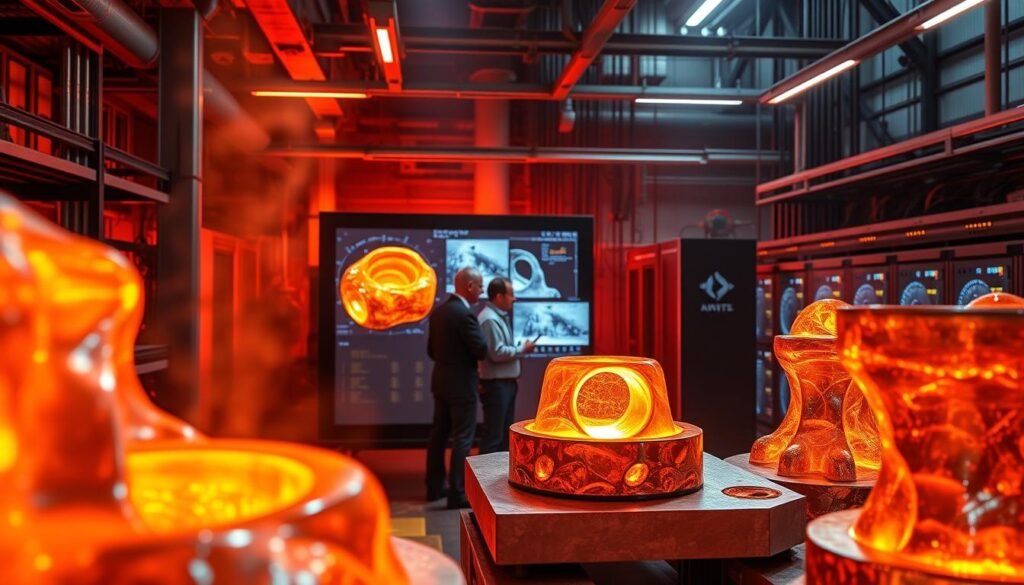
We look at the software that helps modern foundries. It shapes how work flows, how fast, and how well we can track it. From filling molds to analyzing distortions, each tool offers a mix of physics, ease of use, and support.
Overview of industry-leading software packages
MAGMASOFT from MAGMA GmbH is a top choice for foundry engineers. It’s known for its accurate mold filling, solidification models, and optimization tools. It supports a process-driven workflow and has a big user community for sharing best practices.
ESI ProCAST focuses on thermal-stress and casting physics. It handles complex alloys and large castings well. Users trust its models to predict issues like shrinkage and residual stress.
Flow-3D Cast is great for mold filling and free-surface flow. Its CFD core accurately models turbulent entrainment and air entrapment. It’s perfect when you need to understand mold filling behavior.
Altair Inspire Cast links casting simulation with topology optimization. It lets designers optimize shapes for less mass and better stiffness. This is useful for making lightweight car parts and quick design changes.
Simufact specializes in predicting distortion and assembly behavior after solidification. It combines process-aware deformation modeling with manufacturing concerns. This gives realistic estimates of post-cast machining and fit.
Open-source vs. commercial options
Most foundry simulation technology is commercial. This is because casting physics and material databases need validation and support. Vendors provide tested models, support, and certified material libraries, which reduce risk for manufacturers.
OpenFOAM is an open-source option for CFD in filling studies. It can model free-surface flows and transient heat transfer. But, it needs customization and scripting, unlike commercial software.
The choice is clear: open-source is cheaper but commercial offers faster deployment and support. Teams should consider their staff’s skills, time, and the need for validated models when choosing.
Integration with CAD and PLM systems
Seamless integration with CAD and PLM is key for efficient digital design tools. Most packages connect to SolidWorks, Siemens NX, and PTC Creo. This lets geometry flow directly from design to simulation.
PLM systems like Siemens Teamcenter or PTC Windchill capture simulation reports and history. This ensures change control and gives teams a single source of truth for design decisions.
Well-integrated workflows speed up iteration. We import CAD, run simulations, store results in PLM, and refine geometry. This loop reduces rework and keeps data consistent across functions.
How to Set Up a Casting Simulation: From CAD to Results

We help foundry teams turn design ideas into useful insights. Our steps are simple and focus on making the casting process better. We use the latest 3d simulation software.
Preparing the CAD model for simulation
Start by importing your CAD model. Use formats like STEP and IGES if needed. Then, fix any gaps and remove small details that don’t affect the physics.
Next, set up parting lines and split cores and cavities. Make separate mold and core bodies. Include gating and riser geometry to match real-world feeding paths.
Choosing material properties and boundary conditions
Choose the right alloy data, like liquidus and solidus temperatures. Also, pick mold material properties and set sand mold permeability.
Set the initial metal temperature and mold preheat. Add ambient conditions and heat transfer coefficients. These details are key for accurate solidification and porosity predictions.
Setting gates, risers, and mold parameters
Place gates for smooth filling and avoid air traps. Size them right for the filling time and velocity. Choose riser types based on casting geometry and feeding locations.
Add chills and vents for thermal gradients and gas issues. Use thermal modulus to find the best riser locations. The simulation checks feeding efficiency before actual casting.
Running the simulation and interpreting outputs
Run the simulation using 3d software. Look at filling time maps, velocity fields, and air entrapment zones. Also, check thermal gradients and solidification front progression.
Watch for hot spots and last-to-solidify zones. Use distortion plots for dimensional checks. Overlay contours on the CAD model and export data for reports.
We adjust settings based on simulation results. Small changes can lead to big improvements in quality and time savings. This is the power of a robust metal casting simulation workflow.
Simulation Workflows for Casting Process Optimization
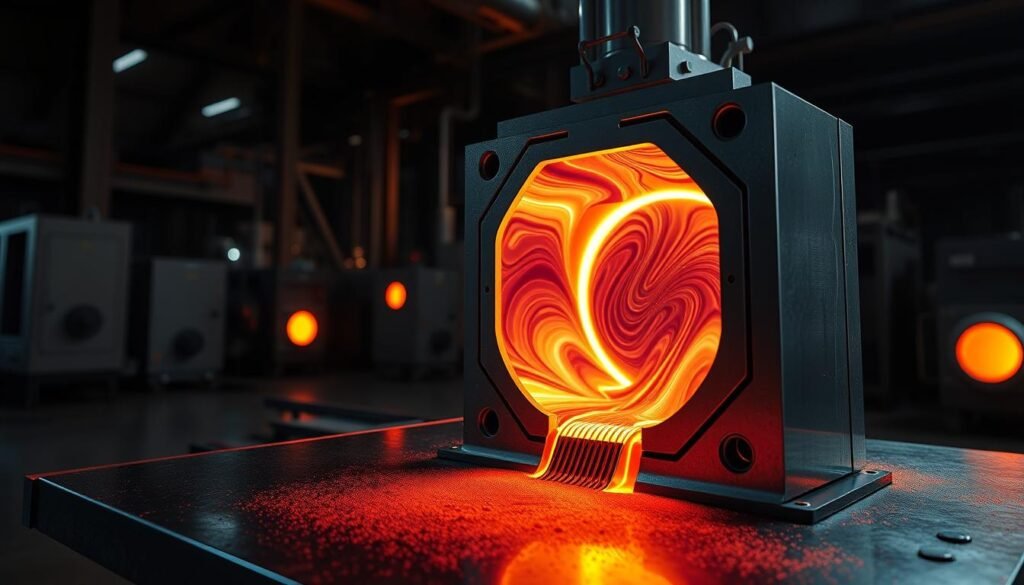
We create practical workflows to help foundries move from trial-and-error to data-driven production. These workflows combine metal casting simulation with lean engineering and virtual foundry tools. This speeds up decision-making.
Iterative design and optimization loops
We start each loop with a baseline simulation. We run a full pour and check temperature fields for porosity or cold shuts. Then, we make small changes and re-simulate to see the effects.
This method makes optimization efficient. It reduces physical trials and speeds up finding the best solution. Companies like Mahindra and TATA Advanced Systems use it to cut waste and stabilize production.
Design of experiments and parametric studies
We focus on key variables like pour temperature and mold material in our studies. A design of experiments (DOE) lets us vary these factors systematically. This helps us understand how they interact.
DOE reduces the number of runs needed. It shows which settings work best. This information helps create safe operating windows and supports production plans in India and worldwide.
Automated optimization and sensitivity analysis
We use algorithms for final tuning. Tools like gradient-based solvers and genetic algorithms help find the best solutions. Surrogate models speed up repeated evaluations.
Sensitivity analysis tells us which inputs are most important. This guides where to focus process control. With virtual foundries and cloud computing, teams can run wide optimization campaigns overnight.
| Workflow Item | Typical Tools | Primary Benefit |
|---|---|---|
| Baseline simulation | ProCAST, MAGMA, Simufact | Identifies initial defects and thermal behavior |
| Iterative adjustments | CAD + metal casting simulation loops | Fast convergence with minimal prototypes |
| DOE / parametric study | Design-Expert, JMP, in-house scripts | Quantifies factor effects and interaction terms |
| Automated optimization | Gradient solvers, genetic algorithms, surrogate models | Finds optimal trade-offs between quality and cycle time |
| Sensitivity analysis | Variance-based methods, Sobol indices | Prioritizes control variables for process stability |
Predicting and Preventing Casting Defects with Simulation
We use simulation to make casting runs more predictable. Metal casting simulation lets engineers see inside molds. They can spot where flow will stall and where gases will build up.
CFD-based filling simulations show air entrapment zones and turbulent flow. We track velocity vectors and pressure fields. This helps us find areas at risk for gas entrapment.
Solidification models help predict shrinkage porosity. We calculate local solid fraction, cooling rate, and feeding efficiency. This way, we can map out risk areas.
Coupled thermal-mechanical solvers predict residual stress and dimensional change. They show how cooling and tooling create distortion. We use this to plan tooling adjustments and process changes.
Optimizing feeding and solidification paths is key to preventing defects. We can resize or relocate risers, add chills, or change gate direction. Simulation helps us test these changes quickly and reliably.
Foundry simulation technology speeds up iteration. We can run studies to compare different layouts and placements. The goal is to ensure proper feeding and minimize voids before the first trial pour.
Predicting shrinkage and porosity prediction work together. Filling analysis feeds solidification models, and mechanical analysis closes the loop. This integrated approach reduces rework and improves yields, making virtual testing essential in foundries worldwide.
Material Savings and Cost Reduction through Virtual Testing
We look at how virtual testing saves money and material in foundries. Metal casting simulation helps teams spot defects and risks early. This leads to better choices on gating, risering, and alloy use before the first pour.
Reducing scrap and rework rates
Simulation-driven changes often lower defect counts. Plants see first-pass yield go from 70–80% to 90–96% with simulation. This cuts down on lost pours, energy waste, and rework labor.
Less scrap means smaller inventory and less capital tied up. Shops using Magma or FLOW-3D Cast see less porosity and shrinkage. This reduces repair time and customer returns.
Minimizing expensive prototype iterations
Virtual testing cuts down on full-scale prototype pours. We estimate savings of 40–60% in pattern tooling and alloy charges. Rapid digital changes find design flaws early, leading to fewer pattern modifications and lab tests.
Shorter validation loops speed up time-to-market and reduce opportunity cost. For manufacturers moving to lean workflows, these savings add up across product lines.
Calculating ROI for simulation investments
ROI simulation starts with a simple template. It compares annual avoidable costs to annualized simulation expenses. Count reduced scrap, fewer tooling iterations, lower warranty claims, and faster revenue realization as benefits.
| Item | Annual Avoidable Cost (INR) | Notes |
|---|---|---|
| Scrap and lost pours | 8,000,000 | Based on yield improvement and metal cost savings |
| Prototype tooling and pattern changes | 3,200,000 | Reduction from fewer physical iterations |
| Rework and labor | 1,500,000 | Lower defect repairs and inspection time |
| Warranty and field returns | 2,000,000 | Improved quality lowers downstream costs |
| Total annual avoidable costs | 14,700,000 | Conservative example for a mid-size foundry |
| Annualized simulation expense | 3,000,000 | Software, hardware/cloud, training |
| Payback period | ~0.2 years (≈3 months) | Total avoidable / annualized expense |
We suggest a stepwise ROI simulation: 1) quantify baseline costs; 2) model expected yield uplift and prototype reductions; 3) sum annual avoidable costs; 4) divide by total annual simulation expense to get payback. Use conservative assumptions and run sensitivity checks.
Adopting metal casting simulation is key to manufacturing transformation. It leads to material savings, lower cycle costs, and faster launches. This makes a strong case for software and cloud investment.
Industry Applications: Automotive, Aerospace, Heavy Machinery, and Tool-making
We look at how simulation changes casting in different fields. In India, engineers and foundry managers want to speed up processes, improve safety, and make complex parts. Virtual workflows help teams test ideas before making the first pattern.
Automotive: lightweight components and cycle time improvements
Car makers aim for lighter engine blocks, cylinder heads, and more. They use aluminum alloys to save fuel and keep parts strong.
Simulation in automotive casting cuts down on defects and predicts how thin walls will fill. This makes it possible to make parts faster and improve their sound without expensive prototypes.
Aerospace: safety-critical castings and certification aids
Aircraft parts need to be reliable and consistent. Investment casting often makes these complex shapes.
Simulation helps predict how aerospace castings will perform and supports certification. Boeing and Airbus value this data for faster approval and less variability.
Heavy machinery: large-scale castings and shrinkage control
Big castings are used in mining and construction. But, they can have problems like hot tears and uneven cooling.
Simulation helps plan where to put risers and chills, and how to scale and cool large parts. This reduces mistakes and shortens the time to make big components.
Tool-making: dies, molds, and precision casting optimization
Tool-makers create dies and molds for precise parts. Costly mistakes and poor gating are big issues.
Simulation optimizes how to cast and predicts wear. This leads to better tooling for serial production.
Virtual foundries help test materials, gating, and cooling quickly. This means fewer physical tests, better records, and faster market entry for complex castings.
Real-World Example: Cost and Time Savings from a Simulation Project
We have a real example to show how metal casting simulation helps an Indian auto supplier. They worked on an aluminum transmission housing with problems like porosity, long times, and missed deadlines. Their goals were to fix porosity, shorten time, and meet schedules.
Project background and objectives
The supplier made many castings for car transmissions each shift. They had high scrap rates and kept changing tools, which delayed shipments to big names like Maruti Suzuki and Tata Motors. They aimed to cut scrap, limit prototype pours, and shorten production time while keeping costs down.
Simulation steps taken and design changes implemented
We started by using MAGMASOFT and Flow-3D Cast to check the design. We focused on thin parts and complex shapes. Simulations showed problems in the lower flange and at the primary gate.
We added side risers and chills to fix these issues. We also changed the gate to improve flow. We tested different pour temperatures and riser sizes to find the best settings. Each change was checked to make sure it worked before making new tools.
Quantified savings in cost, time, and defect reduction
The results were amazing: scrap went from 8% to 1.5%, and prototype pours from four to one. Costs for reworking tools went down by 25–40%. Cycle times and fewer reworks saved 30–50% of production time, helping them meet deadlines.
The cost savings were quick: less waste, fewer lost machine hours, and better on-time delivery paid off in months. This shows how focused improvements in casting, backed by simulation, can save money and time for foundries in India’s auto sector.
Implementing Metal Casting Simulation in Indian Manufacturing Environments
We need practical steps for foundries to adopt digital workflows. India’s foundry sector has big OEMs and many small shops. This mix leads to quality and skill gaps. We must focus on metal casting simulation in India and training.
Local industry needs and common casting challenges in India
Indian foundries face issues with raw material quality and molding techniques. Cost limits trying new things. This leads to defects and unpredictable delivery times. Foundry simulation technology can help standardize processes for all sizes.
Infrastructure and training considerations
Success needs the right computer setup and material data. Some shops use local workstations, while others prefer cloud-based solutions. A mix of both is recommended.
Teams need training tools and material libraries. A mix of workshops, mentoring, and academic partnerships works well. This approach builds skills and creates a talent pipeline.
Partnering with software vendors and service providers
Choose vendors with local support and Indian success stories. Global platforms like Siemens, Altair, and ESI offer on-site training. Look for cloud licensing, local language support, and case studies.
Start with a consultancy or foundry simulation center for pilot studies. They can help with quick wins and training plans. This builds confidence in simulation technology.
A phased strategy is best: start with key parts, run simulations, then scale. This approach helps manufacturers improve quality while controlling costs. It also builds long-term simulation capability.
Emerging Technologies: AI, Cloud Computing, and Digital Twins
We look at how new tools change metal casting simulation and foundry work. These tools speed up design, improve quality, and share data across teams in India and worldwide.
How AI improves accuracy and speed
Machine learning creates quick models that stand in for complex physics solvers. This lets us test many designs without waiting for detailed simulations.
AI makes spotting defects easier by analyzing data from simulations and tests. It finds stable process settings with less manual effort.
AI also digs into historical data to find the causes of problems. This speeds up improvement and makes AI a key tool for development teams.
Benefits of cloud-based simulation and collaboration
Cloud-based simulation offers more computing power for big models and detailed solves. It saves money on IT and gives access to powerful GPUs when needed.
Cloud services and software vendors make it easier to start. Teams can work together, share models, and review results in real time.
Big cloud platforms like AWS, Microsoft Azure, and Google Cloud host simulation workloads. They partner with software vendors to offer complete solutions for metal casting simulation.
Digital twins for continuous improvement
A digital twin is a live model that mirrors a foundry’s operations. It uses sensor data, process parameters, and production history for a real-time simulation.
Digital twins allow for real-time predictions and control. We can adjust pouring rates or mold temperatures before defects occur.
They also lead to predictive maintenance and designs that are easier to make. Combining AI with digital twins makes ongoing improvements possible.
Best Practices for Successful Foundry Simulation Adoption
We help foundries follow clear steps to make simulation a regular part of their work. This includes smooth data flows, consistent templates, and small validation tests. These steps keep projects on track and within budget.
Setting up a simulation-ready workflow
Begin by setting up a system that moves data smoothly from CAD to simulation to PLM. Use clear naming and version control to track changes easily. Create templates for common castings and keep material libraries up-to-date. This makes your workflow efficient and cuts down on unnecessary work.
Training teams and building multidisciplinary capabilities
Bring together teams with metallurgists, process engineers, CAD designers, and quality experts. Teach software skills alongside metallurgy to give context to simulation results. Use real-world projects from vendors like Altair, Magmasoft, or Ansys to train staff.
Offer training that mixes classroom learning with hands-on practice. Encourage teamwork and peer reviews to share knowledge. This builds confidence in using simulation technology every day.
Validating simulation results with targeted experiments
Plan small, focused tests to check simulation predictions. Use thermocouples for cooling curves, radiography and CT scans for defects, and metrology for shape accuracy. Compare these results with simulation outputs and adjust settings as needed.
Keep refining your validation process with small tests. This builds trust in simulation results and speeds up the time from insight to action.
By following these steps—setting up a solid workflow, training teams, and validating results—you can make simulation technology a key part of Indian manufacturing. It leads to consistent savings and quality improvements.
Future Outlook: Why Adopting Metal Casting Simulation Is Essential
We think it’s time for foundries to adopt future casting simulation. The global market wants faster production, better quality, and more eco-friendly practices. Using virtual foundries can help meet these needs by cutting down on trial and error and improving quality right from the start.
New technologies will push this change forward. We’ll see better use of AI and physics in simulations, more cloud-based tools for small businesses, and digital twins for ongoing improvement. These changes will make advanced manufacturing easier and more widespread in India’s supply chain.
Foundries, OEMs, and engineering programs should start by investing in pilot projects and training. This will lead to less waste, quicker product development, and more chances to sell products abroad. By combining our knowledge with creative problem-solving, we can make Indian foundries more efficient, lean, and green.


Leave a Reply